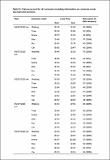Por favor, use este identificador para citar o enlazar a este item:
http://hdl.handle.net/10261/221117COMPARTIR / EXPORTAR:
 SHARE SHARE
 CORE
BASE CORE
BASE
|
|
| Visualizar otros formatos: MARC | Dublin Core | RDF | ORE | MODS | METS | DIDL | DATACITE | |

| Campo DC | Valor | Lengua/Idioma |
|---|---|---|
| dc.contributor.author | Moreno, Teresa | es_ES |
| dc.contributor.author | Reche, Cristina | es_ES |
| dc.contributor.author | Ahn, Kang-Ho | es_ES |
| dc.contributor.author | Eun, Hee Ram | es_ES |
| dc.contributor.author | Kim, Woo Young | es_ES |
| dc.contributor.author | Kim, Hee-Sang | es_ES |
| dc.contributor.author | Fernández-Iriarte, Amaia | es_ES |
| dc.contributor.author | Amato, Fulvio | es_ES |
| dc.contributor.author | Querol, Xavier | es_ES |
| dc.date.accessioned | 2020-10-14T08:16:13Z | - |
| dc.date.available | 2020-10-14T08:16:13Z | - |
| dc.date.issued | 2020-12 | - |
| dc.identifier.citation | Environmental Research 191: 109978 (2020) | es_ES |
| dc.identifier.uri | http://hdl.handle.net/10261/221117 | - |
| dc.description.abstract | Portable miniaturised scanning mobility particle sizer (SMPS) instruments measuring atmospheric particles within the 10–241 nm size range were used to track particle number size distributions and concentrations during near-simultaneous pedestrian, bicycle, bus, car, tram and subway commuting journeys in Barcelona, Spain on 4th-6th July 2018. The majority of particles in this size range were <100 nm, with k-means cluster analysis identifying peaks at 15–22 nm, 30–40 nm, and 45–75 nm. Around 10–25% of the particles measured however were >100 nm (especially in the subway environment) and so lie outside the commonly defined range of “ultrafine” particles (UFP, or <100 nm particles). The study demonstrated in detail how personal exposure to quasi-UFP (QUFP, <241 nm), most of which present in the city streets are produced by road traffic, varies greatly depending on the transport mode and route chosen. Proximity to fresh traffic exhaust sources, such as in a car with open windows, on-road cycling, walking downwind of busy roads, or in a subway station contaminated by roadside air, enhances commuter exposure to particles <30 nm in size. In contrast, travelling inside air-conditioned bus or tram offers greater protection to the commuter from high concentrations of fresh exhaust. Ultrafine number size distributions in traffic-contaminated city air typically peak in the size range 30–70 nm, but they can be shifted to finer sizes not only by increased content of fresh proximal exhaust emissions but also by bursts of new particle formation (NPF) events in the city. One such afternoon photochemical nucleation NPF event was identified during our Barcelona study and recognised in different transport modes, including underground in the subway system. The integration of static urban background air monitoring station information with particle number concentration and size distribution data obtained from portable miniaturised SMPS instruments during commuting journeys opens new approaches to investigating city air quality by offering a level of detail not previously available. | es_ES |
| dc.description.sponsorship | The authors thank the following colleagues who helped carry the Hy-SMPS instrument on the commuting journeys: Andrés Alastuey, Cristina Carnerero, Miguel Escudero, Maria Izquierdo, Alessia Mancuso, Antonio Pacitto, Marco Pandolfi, Anna Ripoll, Apostolos Salmatonidis, Mar Viana, Jesus Yus. This work was supported by the Spanish Ministry of Economy and Competitiveness and FEDER funds within the I + D Projects CGL 2016-78594-R (HOUSE) and CGL 2016–79132 (BUSAIR), and the Catalan Research Agency (AGAUR 2017 SGR41) of the Generalitat de Catalunya. | es_ES |
| dc.language.iso | eng | es_ES |
| dc.publisher | Elsevier | es_ES |
| dc.relation | info:eu-repo/grantAgreement/MINECO/Plan Estatal de Investigación Científica y Técnica y de Innovación 2013-2016/CGL 2016-78594-R | es_ES |
| dc.relation | info:eu-repo/grantAgreement/MINECO/Plan Estatal de Investigación Científica y Técnica y de Innovación 2013-2016/CGL 2016–79132 | es_ES |
| dc.relation.isversionof | Publisher's version | es_ES |
| dc.rights | openAccess | es_ES |
| dc.subject | Commuting air quality | es_ES |
| dc.subject | SMPS | es_ES |
| dc.subject | Ultrafine | es_ES |
| dc.subject | New particle formation | es_ES |
| dc.subject | Nucleation | es_ES |
| dc.subject | Road traffic | es_ES |
| dc.subject | Nanoparticles | es_ES |
| dc.title | Using miniaturised scanning mobility particle sizers to observe size distribution patterns of quasi-ultrafine aerosols inhaled during city commuting | es_ES |
| dc.type | artículo | es_ES |
| dc.identifier.doi | 10.1016/j.envres.2020.109978 | - |
| dc.description.peerreviewed | Peer reviewed | es_ES |
| dc.relation.publisherversion | https://doi.org/10.1016/j.envres.2020.109978 | es_ES |
| dc.contributor.funder | Ministerio de Economía y Competitividad (España) | es_ES |
| dc.relation.csic | Sí | es_ES |
| oprm.item.hasRevision | no ko 0 false | * |
| dc.identifier.funder | http://dx.doi.org/10.13039/501100003329 | es_ES |
| dc.contributor.orcid | Moreno, Teresa [0000-0003-3235-1027] | es_ES |
| dc.contributor.orcid | Reche, Cristina [0000-0002-3387-3989] | es_ES |
| dc.contributor.orcid | Amato, Fulvio [0000-0003-1546-9154] | es_ES |
| dc.contributor.orcid | Querol, Xavier [0000-0002-6549-9899] | es_ES |
| dc.type.coar | http://purl.org/coar/resource_type/c_6501 | es_ES |
| item.cerifentitytype | Publications | - |
| item.openairecristype | http://purl.org/coar/resource_type/c_18cf | - |
| item.grantfulltext | open | - |
| item.openairetype | artículo | - |
| item.fulltext | With Fulltext | - |
| item.languageiso639-1 | en | - |
| Aparece en las colecciones: | (IDAEA) Artículos | |
Ficheros en este ítem:
| Fichero | Descripción | Tamaño | Formato | |
|---|---|---|---|---|
| 1-s2.0-S0013935120308756-main.pdf | Artículo principal | 13,57 MB | Adobe PDF |  Visualizar/Abrir |
| 1-s2.0-S0013935120308756-mmc1.pdf | Material suplementario | 897,7 kB | Adobe PDF |  Visualizar/Abrir |
CORE Recommender
SCOPUSTM
Citations
9
checked on 26-abr-2024
WEB OF SCIENCETM
Citations
7
checked on 26-feb-2024
Page view(s)
110
checked on 27-abr-2024
Download(s)
219
checked on 27-abr-2024
Google ScholarTM
Check
Altmetric
Altmetric
NOTA: Los ítems de Digital.CSIC están protegidos por copyright, con todos los derechos reservados, a menos que se indique lo contrario.
